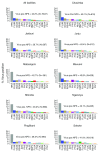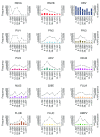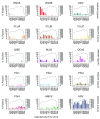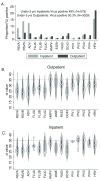Surveillance of respiratory viruses in the outpatient setting in rural coastal Kenya: baseline epidemiological observations
- PMID: 30175247
- PMCID: PMC6081997
- DOI: 10.12688/wellcomeopenres.14662.1
Surveillance of respiratory viruses in the outpatient setting in rural coastal Kenya: baseline epidemiological observations
Abstract
Background: Endemic and seasonally recurring respiratory viruses are a major cause of disease and death globally. The burden is particularly severe in developing countries. Improved understanding of the source of infection, pathways of spread and persistence in communities would be of benefit in devising intervention strategies. Methods: We report epidemiological data obtained through surveillance of respiratory viruses at nine outpatient health facilities within the Kilifi Health and Demographic Surveillance System, Kilifi County, coastal Kenya, between January and December 2016. Nasopharyngeal swabs were collected from individuals of all ages presenting with acute respiratory infection (ARI) symptoms (up to 15 swabs per week per facility) and screened for 15 respiratory viruses using real-time PCR. Paediatric inpatient surveillance at Kilifi County Hospital for respiratory viruses provided comparative data. Results: Over the year, 5,647 participants were sampled, of which 3,029 (53.7%) were aged <5 years. At least one target respiratory virus was detected in 2,380 (42.2%) of the samples; the most common being rhinovirus 18.6% (1,050), influenza virus 6.9% (390), coronavirus 6.8% (387), parainfluenza virus 6.6% (371), respiratory syncytial virus (RSV) 3.9% (219) and adenovirus 2.7% (155). Virus detections were higher among <5-year-olds compared to older children and adults (50.3% vs 32.7%, respectively; χ 2(1) =177.3, P=0.0001). Frequency of viruses did not differ significantly by facility (χ 2(8) =13.38, P=0.072). However, prevalence was significantly higher among inpatients than outpatients in <5-year-olds for RSV (22.1% vs 6.0%; χ 2(1) = 159.4, P=0.0001), and adenovirus (12.4% vs 4.4%, χ 2(1) =56.6, P=0.0001). Conclusions: Respiratory virus infections are common amongst ARI outpatients in this coastal Kenya setting, particularly in young children. Rhinovirus predominance warrants further studies on the health and socio-economic implications. RSV and adenovirus were more commonly associated with severe disease. Further analysis will explore epidemiological transmission patterns with the addition of virus sequence data.
Keywords: Outpatient; Respiratory viruses; Surveillance; Real-time PCR; Nasopharyngeal samples; Coastal Kenya.
Conflict of interest statement
No competing interests were disclosed.
Figures






Similar articles
-
Surveillance of respiratory viruses among children attending a primary school in rural coastal Kenya.Wellcome Open Res. 2020 Sep 24;5:63. doi: 10.12688/wellcomeopenres.15703.2. eCollection 2020. Wellcome Open Res. 2020. PMID: 33102784 Free PMC article.
-
Continuous Invasion by Respiratory Viruses Observed in Rural Households During a Respiratory Syncytial Virus Seasonal Outbreak in Coastal Kenya.Clin Infect Dis. 2018 Oct 30;67(10):1559-1567. doi: 10.1093/cid/ciy313. Clin Infect Dis. 2018. PMID: 29668861 Free PMC article.
-
Severe acute respiratory infection in children in a densely populated urban slum in Kenya, 2007-2011.BMC Infect Dis. 2015 Feb 25;15:95. doi: 10.1186/s12879-015-0827-x. BMC Infect Dis. 2015. PMID: 25879805 Free PMC article.
-
[Viral etiology of acute respiratory tract infection among pediatric inpatients and outpatients from 2010 to 2012 in Beijing, China].Zhonghua Er Ke Za Zhi. 2013 Apr;51(4):255-9. Zhonghua Er Ke Za Zhi. 2013. PMID: 23927797 Chinese.
-
Effects of Non-Pharmacological Interventions on Respiratory Viruses Other Than SARS-CoV-2: Analysis of Laboratory Surveillance and Literature Review From 2018 to 2021.J Korean Med Sci. 2022 May 30;37(21):e172. doi: 10.3346/jkms.2022.37.e172. J Korean Med Sci. 2022. PMID: 35638198 Free PMC article. Review.
Cited by
-
Whole genome analysis of local Kenyan and global sequences unravels the epidemiological and molecular evolutionary dynamics of RSV genotype ON1 strains.Virus Evol. 2018 Sep 24;4(2):vey027. doi: 10.1093/ve/vey027. eCollection 2018 Jul. Virus Evol. 2018. PMID: 30271623 Free PMC article.
-
Genomic epidemiology and evolutionary dynamics of respiratory syncytial virus group B in Kilifi, Kenya, 2015-17.Virus Evol. 2020 Jul 15;6(2):veaa050. doi: 10.1093/ve/veaa050. eCollection 2020 Jul. Virus Evol. 2020. PMID: 32913665 Free PMC article.
-
Genetic characterization of influenza A(H3N2) viruses circulating in coastal Kenya, 2009-2017.Influenza Other Respir Viruses. 2020 May;14(3):320-330. doi: 10.1111/irv.12717. Epub 2020 Jan 13. Influenza Other Respir Viruses. 2020. PMID: 31943817 Free PMC article.
-
The national burden of influenza-like illness and severe respiratory illness overall and associated with nine respiratory viruses in South Africa, 2013-2015.Influenza Other Respir Viruses. 2022 May;16(3):438-451. doi: 10.1111/irv.12949. Epub 2022 Feb 11. Influenza Other Respir Viruses. 2022. PMID: 35150059 Free PMC article.
-
Molecular Epidemiology of Human Rhinovirus From 1-Year Surveillance Within a School Setting in Rural Coastal Kenya.Open Forum Infect Dis. 2020 Aug 27;7(10):ofaa385. doi: 10.1093/ofid/ofaa385. eCollection 2020 Oct. Open Forum Infect Dis. 2020. PMID: 33094115 Free PMC article.
References
Grants and funding
LinkOut - more resources
Full Text Sources
Other Literature Sources

